According to a 2016 survey of the National Dental Practice Based Research Network, the top material choices for anterior crowns were lithium disilicate and layered zirconia whereas the top choice for posterior crowns was monolithic zirconia.1 Polishing high strength ceramics, such as zirconia and lithium disilicate, can be a clinical challenge due to the hardness of these materials. A recent survey of the American Dental Association Clinical Evaluators Panel reported that 5% of respondents identified challenges with polishing as the main disadvantage of using zirconia.2 Polishing ceramic materials is important for maintaining the esthetics of a restoration, preventing wear of opposing enamel, reducing plaque accumulation on a ceramic, and preserving patient comfort. This article will review different aspects of polishing including types of polishers, polishing techniques and the effects of ceramic polishing on properties of ceramics.
Types of ceramic polishers
Polishers are generally composed of abrasive particles embedded into a polymer binder. The abrasive particles can be made of different ceramic materials, such as diamonds, aluminum dioxide or silicon carbide. Generally, diamonds are harder and more aggressive polishers than those composed of alumina or silicon carbide. The abrasive particles can also vary in size, with larger size particles in the polishers at the beginning of a polishing sequence (Fig. 1) and smaller particles in the polishers in the later stages of a polishing sequence. (Fig. 2) The concept of polishing is that the abrasive particles will create smaller and smaller scratches on the surface of a material until the scratches are no longer visually or tactilely perceptible. Polishers also obtain their ability to produce smoother scratches because their abrasives are more loosely adhered into their binder compared to the rigid stabilization of abrasives in a diamond rotary bur. Similarly polishing pastes may be able to achieve an even higher degree of polish as they are composed of loose abrasive particles suspended in a liquid paste.
Fig. 1

Fig. 2

The other major component of polishers is the binder, the material that gives the polisher its shape and holds in the abrasive particles. Harder binders will polish more aggressively and may also prolong the shape of the polisher. Polishers with softer binders on the other hand will provide a gentler polish that would be less likely to indent the surface they are polishing. Many polishers use rubber-like binder composed of polyurethane – the stiffness of the polyurethane binder may be adjusted based on the brand of the polisher. Some composite polishers will use urethane dimethacrylate resin-like binder that crumbles more. A rubber type of polisher will last longer but a resin-like polisher may be able to polish more aggressively since as the binder crumbles, new abrasive particles will be exposed.
There are also pre-polishers which can be referred to as polishing stones. Polishing stones may be composed of solid aluminum dioxide, which is a ceramic. There are some pre-polishers that are composed of diamond particles embedded into a relatively hard epoxy binder that have a similar hardness as a polishing stone. Due to their hard binder, these pre-polishers may be aggressive enough to perform adjustments and shape refinements of dental ceramics. The hard binder also helps to preserve the shape of the pre-polishers during use. As the pre-polishers are composed of ceramics (such as aluminum oxide) or a polymer (such as the epoxy binder) which are both heat insulators, they are less likely to generate heat than metal-based diamond rotary bur.
Most high strength ceramic polishing kits used for zirconia and lithium disilicate, such as the Kut Ultimate Polisher kit (Dental Savings Club, Fig. 3), are composed of 2 steps. The first step is composed of medium sized diamond abrasives embedded in a relatively stiff polyurethane binder. The second step contains smaller diamonds also embedded in a polyurethane binder. The Kut Ultimate Polisher kit also contains a stiffer pre-polisher composed of diamonds embedded in a stiff artificial rubber binder.
Fig. 3

The pre-polisher and polishers included in the Kut Ultimate Polisher kit and a fine diamond rotary instrument were used to polish 3Y zirconia with a gentle back-and-forth motion for 30 seconds. The 3Y zirconia specimen was then examined with non-contact surface profilometry to observe the roughness of the specimens after each step. (Fig. 4) The pre-polisher created a rougher surface than the fine diamond rotary bur. The use of the first step of the polisher produced a much smoother surface. Progressing to the second polisher further improved the surface roughness.
Fig. 4
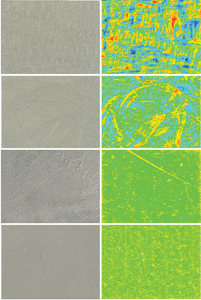
Polishing technique
Although it may seem obvious, the use of 2 step high-strength ceramic polishers in sequence is important for achieving ideal smoothness. The first step smooths scratches produced from adjustment from the diamond bur. And the second step further reduces the size of the scratches. Previous research suggests that the first step of polishing following adjustment with a diamond bur produces a more substantial decrease in roughness than the effects of polishing with a successive polishing step.3 Additionally, if a fine polisher (2nd step) is attempted immediately following adjustment with a diamond bur, the surface will be left significantly rougher than if a medium polisher (1st step) is used in between the adjustment and fine polisher.4
The speed at which the ceramic is polished may vary based on the recommendations of the manufacturers of different polishers. A laboratory study reported that polishing at speeds of 5,000 rotations per minute (RPM) and 40,000 RPM were both less effective than polishing at 15,000 RPM.5 Aside from being less efficient, polishing at a higher RPM than needed will reduce the lifetime of the polisher and produce excess heat. In the authors experience, a polishing speed around 10,000-12,000 RPM is most efficient.
Polishing with water lubrication should improve the effectiveness of polishing as the water spray may remove debris from the polisher and ground ceramic. Additionally, water spray may help prevent overheating the pulp if the tooth is still vital. When adjusting ceramic restorations, heat can be transmitted from the external surface of the restoration, through the restoration (ceramic is a heat insulator not a conductor), and through the remaining tooth structure. Thermal pulp damage has been shown to occur with temperature increases of 5.5C in monkeys,6 however, research of human teeth has shown pulp vitality maintained with a temperature increase of 17C.7 Polishing through 1mm of zirconia without water has shown to produce a temperature increase of around 10C.5 Assuming additional remaining dentin thickness, the temperature increase in the pulp should be even lower. Therefore, polishing a zirconia restoration without water lubrication would not be expected to increase pulpal temperature to a dangerous level. Adjusting zirconia dry with a diamond bur, however, has shown to increase temperature by 40C.8 Therefore, water lubrication should always be employed when making adjustments with a diamond bur.
Intra-oral polishers are often supplied in various shapes, such as points, cups and discs. Points are useful for occlusal surfaces, (Fig. 5) cingulum surfaces, (Fig. 6) anterior line angles, and cervical margins. The internal surface of a cup can be used on cusps, (Fig. 7) cervical margins, (Fig. 8) and embrasure spaces. If turned on its side, a cup can also be used for polishing flat areas. (Fig. 9) Discs are useful for flat surfaces such as the incisal edge of anterior teeth (Fig. 10) or proximal surface of posterior teeth. (Fig. 11) If significant polishing of a ceramic crown is required after extra-oral adjustment with a diamond bur, a laboratory polisher may be employed. The increased torque supplied by a laboratory polisher and the larger size of the laboratory polisher makes using laboratory equipment more efficient.
Fig. 5
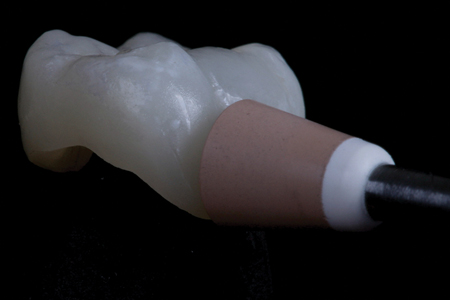
Fig. 6

Fig. 7

Fig. 8
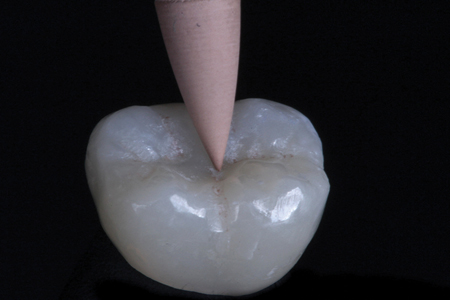
Fig. 9
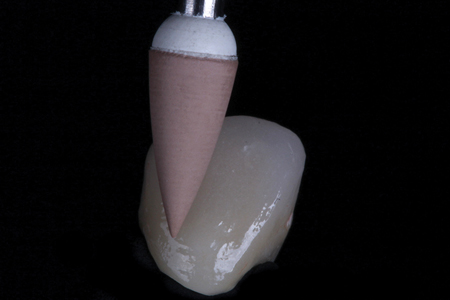
Fig. 10
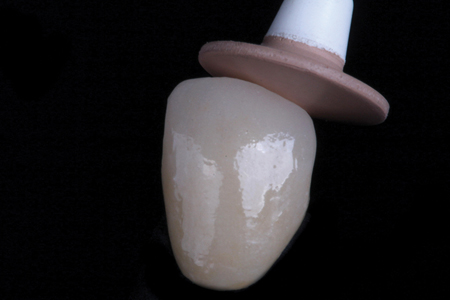
Fig. 11
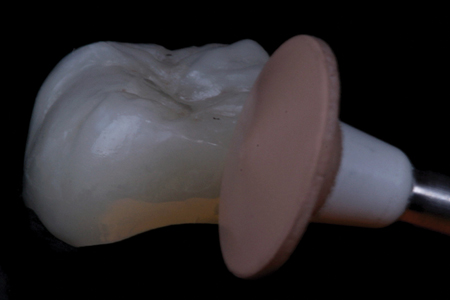
Effects of ceramic polishing on ceramic properties
The most obvious effect of polishing ceramics is a reduction in the roughness of the ceramic. The ceramic roughness can affect its ability to collect plaque biofilm. A review paper concluded that polishing to a threshold of Ra < 0.2 μm was necessary to prevent the formation of a biofilm on dental materials.9 Polishing ceramics also improves patient comfort. A study reported that 60% of participants could correctly differentiate between surfaces with Ra of 0.28 and 0.62 μm, and 76% could differentiate surfaces with Ra of 0.62 and 1.29 μm with the tips of their tongue.10 A goal of polishing is to create the smooth surfaces of a restoration to a roughness below which a patient can sense.
Polishing ceramics may also affect the amount of wear created on opposing enamel. Both zirconia and lithium disilicate are more friendly to opposing tooth structure than porcelain.11 Additionally, for both lithium disilicate and zirconia, the materials are more wear friendly when polished than when glazed.11 The reason that porcelain or glaze causes more enamel wear than polished high strength ceramics is that their surfaces become rough during the wear process. As porcelain or glaze starts to wear, the lower strength of the material allows it to fracture, chip and roughen. High strength ceramics stay relatively smooth due to their higher resistance to chipping and their smaller microstructure. If adjusted with a diamond bur, the polished high strength ceramics can also become more abrasive to opposing enamel. However, if they are repolished, the opposing enamel wear is again minimized.11,12
The strength of lithium disilicate and zirconia may be affected by grinding with a diamond bur. Grinding introduces scratches into the ceramic surface, but presumably it will also introduce cracks within the material. Zirconia behaves differently than lithium disilicate when damaged through grinding. Zirconia (particularly 3 mol% yttria stabilized zirconia) is capable of undergoing transformation toughening.13 This is a process in which crystals within the microstructure of zirconia can expand around a forming crack. The crystal expansion stops the crack growth which allows a “self-healing” ability of zirconia. For lithium disilicate, adjustment with a diamond bur reduces the strength of the material.14,15,16,17 Polishing after grinding, did not seem to improve its strength.15 In one study, strength improvements after grinding on lithium disilicate could be achieved by a heat treatment to heal the cracks.16 For zirconia, some studies showed that grinding with a diamond bur will reduce the strength of zirconia18-24 whereas others show that grinding does not significantly alter its strength (assuming it is 3 mol% yttria stabilized zirconia).23,24 In some studies, polishing zirconia after adjusting would return its strength.18,23,25-28
Summary
Ceramic polishers are composed of diamond abrasive particles embedded into binder. Progressive steps of polishing involve smaller and smaller sized diamond abrasive. The hardness of the binder will determine how aggressively the polisher will remove material. Polishers need to be used in sequence. A polishing speed of 10,000-12,000 RPM with water lubrication is ideal. Polishing may be performed dry, however, adjusting with a diamond bur without water lubrication may lead to thermal pulp damage. Different shapes of polishers are suited for different surfaces of ceramic restorations. Polishing ceramics may reduce biofilm adherence, improve patient comfort, reduce opposing enamel wear, and help prevent strength reduction following diamond bur adjustments (for zirconia).
Oral Health welcomes this original article.
References
- Makhija SK, Lawson NC, Gilbert GH, Litaker MS, McClelland JA, Louis DR, Gordan VV, Pihlstrom DJ, Meyerowitz C, Mungia R, McCracken MS; National Dental PBRN Collaborative Group. Dentist material selection for single-unit crowns: Findings from the National Dental Practice-Based Research Network. J Dent. 2016 Dec;55:40-47. doi: 10.1016/j.jdent.2016.09.010. Epub 2016 Sep 28. PMID: 27693778; PMCID: PMC5125852.
- Lawson NC, Frazier K, Bedran-Russo AK, Khajotia S, Park J, Urquhart O; Council on Scientific Affairs. Zirconia restorations: An American Dental Association Clinical Evaluators Panel survey. J Am Dent Assoc. 2021 Jan;152(1):80-81.e2. doi: 10.1016/j.adaj.2020.10.012. Epub 2020 Nov 26. PMID: 33250170.
- Preis V, Schmalzbauer M, Bougeard D, Schneider-Feyrer S, Rosentritt M. Surface properties of monolithic zirconia after dental adjustment treatments and in vitro wear simulation. J Dent. 2015 Jan;43(1):133-9. doi: 10.1016/j.jdent.2014.08.011. Epub 2014 Aug 28. PMID: 25174949.
- Pfefferle R, Lümkemann N, Wiedenmann F, Stawarczyk B. Different polishing methods for zirconia: impact on surface, optical, and mechanical properties. Clin Oral Investig. 2020 Jan;24(1):395-403. doi: 10.1007/s00784-019-02953-6. Epub 2019 May 18. PMID: 31102049.
- Chavali R, Lin CP, Lawson NC. Evaluation of Different Polishing Systems and Speeds for Dental Zirconia. J Prosthodont. 2017 Jul;26(5):410-418. doi: 10.1111/jopr.12396. Epub 2015 Nov 30. PMID: 26618785; PMCID: PMC4885804.
- Zach L, Cohen G. Pulp response to externally applied heat. Oral Surg Oral Med Oral Pathol. 1965 Apr;19:515-30. doi: 10.1016/0030-4220(65)90015-0. PMID: 14263662.
- Baldissara P, Catapano S, Scotti R. Clinical and histological evaluation of thermal injury thresholds in human teeth: a preliminary study. J Oral Rehabil. 1997 Nov;24(11):791-801. doi: 10.1046/j.1365-2842.1997.00566.x. PMID: 9426160
- Is, eri U, Ozkurt Z, Yalnız A, Kazazoˇg lu E. Comparison of different grinding procedures on the flexural strength of zirconia. J Prosthet Dent. 2012 May;107(5):309-15. doi: 10.1016/S0022-3913(12)60081-X. PMID: 22546308.
- Teughels W, Van Assche N, Sliepen I, et al. Effect of material characteristics and/or surface topography on biofilm development. Clin Oral Implants Res. 2006;17(Suppl 2):68–81.
- Jones CS, Billington RW, Pearson GJ. The in vivo perception of roughness of restorations. Br Dent J. 2004;196:42–45.
- Lawson NC, Janyavula S, Syklawer S, McLaren EA, Burgess JO. Wear of enamel opposing zirconia and lithium disilicate after adjustment, polishing and glazing. J Dent. 2014 Dec;42(12):1586-91. doi: 10.1016/j.jdent.2014.09.008. Epub 2014 Sep 23. PMID: 25257823.
- Tachibana K, Atsuta I, Tsukiyama Y, Kuwatsuru R, Morita T, Yoshimatsu H, Matsushita Y, Narimatsu I, Ayukawa Y, Sawae Y, Koyano K. The need for polishing and occlusal adjustment of zirconia prostheses for wear on antagonist teeth. Dent Mater J. 2021 May 29;40(3):650-656. doi: 10.4012/dmj.2020-190. Epub 2021 Jan 15. PMID: 33456027.
- Zhang F, Reveron H, Spies BC, Van Meerbeek B, Chevalier J. Trade-off between fracture resistance and translucency of zirconia and lithium-disilicate glass ceramics for monolithic restorations. Acta Biomater. 2019 Jun;91:24-34. doi: 10.1016/j.actbio.2019.04.043. Epub 2019 Apr 26. PMID: 31034947.
- Chen XP, Xiang ZX, Song XF, Yin L. Machinability: Zirconia-reinforced lithium silicate glass ceramic versus lithium disilicate glass ceramic. J Mech Behav Biomed Mater. 2020 Jan;101:103435. doi: 10.1016/j.jmbbm.2019.103435. Epub 2019 Sep 20. PMID: 31586883
- Cadore-Rodrigues AC, Machry RV, Zucuni CP, Pereira GKR, Valandro LF. Grinding and polishing of the inner surface of monolithic simplified restorations made of zirconia polycrystals and lithium disilicate glass-ceramic: Effects on the load-bearing capacity under fatigue of the bonded restorations. J Mech Behav Biomed Mater. 2021 Sep 11;124:104833. doi: 10.1016/j.jmbbm.2021.104833. Epub ahead of print. PMID: 34562764
- Hung CY, Lai YL, Hsieh YL, Chi LY, Lee SY. Effects of simulated clinical grinding and subsequent heat treatment on microcrack healing of a lithium disilicate ceramic. Int J Prosthodont. 2008 Nov-Dec;21(6):496-8. PMID: 19149064
- May MM, Fraga S, May LG. Effect of milling, fitting adjustments, and hydrofluoric acid etching on the strength and roughness of CAD-CAM glass-ceramics: A systematic review and meta-analysis. J Prosthet Dent. 2021 Apr 14:S0022-3913(21)00134-7. doi: 10.1016/j.prosdent.2021.02.031. Epub ahead of print. PMID: 33865557
- Lee JY, Jang GW, Park II, Heo YR, Son MK. The effects of surface grinding and polishing on the phase transformation and flexural strength of zirconia. J Adv Prosthodont. 2019 Feb;11(1):1-6. doi: 10.4047/jap.2019.11.1.1. Epub 2019 Feb 26. PMID: 30847043; PMCID: PMC6400711
- Kosmac T, Oblak C, Jevnikar P, Funduk N, Marion L. The effect of surface grinding and sandblasting on flexural strength and reliability of Y-TZP zirconia ceramic. Dent Mater. 1999 Nov;15(6):426-33. doi: 10.1016/s0109-5641(99)00070-6. PMID: 10863444
- Curtis AR, Wright AJ, Fleming GJ. The influence of surface modification techniques on the performance of a Y-TZP dental ceramic.
J Dent. 2006 Mar;34(3):195-206. doi: 10.1016/j.jdent.2005.06.006. Epub 2005 Aug 19. PMID: 16112791 - Manawi M, Ozcan M, Madina M, Cura C, Valandro LF. Impact of surface finishes on the flexural strength and fracture toughness of In-Ceram Zirconia. Gen Dent. 2012 Mar-Apr;60(2):138-42. PMID: 22414507
- Coldea A, Fischer J, Swain MV, Thiel N. Damage tolerance of indirect restorative materials (including PICN) after simulated bur adjustments. Dent Mater. 2015 Jun;31(6):684-94. doi: 10.1016/j.dental.2015.03.007. Epub 2015 Apr 6. PMID: 25858782
- Botelho MG, Dangay S, Shih K, Lam WYH. The effect of surface treatments on dental zirconia: An analysis of biaxial flexural strength, surface roughness and phase transformation. J Dent. 2018 Aug;75:65-73. doi: 10.1016/j.jdent.2018.05.016. Epub 2018 May 26. PMID: 29842902
- Pereira GK, Silvestri T, Camargo R, Rippe MP, Amaral M, Kleverlaan CJ, Valandro LF. Mechanical behavior of a Y-TZP ceramic for monolithic restorations: effect of grinding and low-temperature aging. Mater Sci Eng C Mater Biol Appl. 2016 Jun;63:70-7. doi: 10.1016/j.msec.2016.02.049. Epub 2016 Feb 22. PMID: 27040197
- Zucuni CP, Guilardi LF, Rippe MP, Pereira GKR, Valandro LF. Polishing of Ground Y-TZP Ceramic is Mandatory for Improving the Mechanical Behavior. Braz Dent J. 2018 Sep-Oct;29(5):483-491. doi: 10.1590/0103-6440201802044. PMID: 30517448.
- Lee KR, Choe HC, Heo YR, Lee JJ, Son MK. Effect of different grinding burs on the physical properties of zirconia. J Adv Prosthodont. 2016 Apr;8(2):137-43. doi: 10.4047/jap.2016.8.2.137. Epub 2016 Apr 21. PMID: 27141258; PMCID: PMC4852266.
- Mohammadi-Bassir M, Babasafari M, Rezvani MB, Jamshidian M. Effect of coarse grinding, overglazing, and 2 polishing systems on the flexural strength, surface roughness, and phase transformation of yttrium-stabilized tetragonal zirconia. J Prosthet Dent. 2017 Nov;118(5):658-665. doi: 10.1016/j.prosdent.2016.12.019. Epub 2017 Apr 3. Erratum in: J Prosthet Dent. 2019 Feb;121(2):365. PMID: 28385438.
- Ozer F, Naden A, Turp V, Mante F, Sen D, Blatz MB. Effect of thickness and surface modifications on flexural strength of monolithic zirconia. J Prosthet Dent. 2018 Jun;119(6):987-993. doi: 10.1016/j.prosdent.2017.08.007. Epub 2017 Oct 14. PMID: 29042115.
About the Author
 Nate Lawson is the Director of the Division of Biomaterials and the Program Director of the Biomaterials Residency Program at UAB School of Dentistry.
Nate Lawson is the Director of the Division of Biomaterials and the Program Director of the Biomaterials Residency Program at UAB School of Dentistry.
 Chandani Mantri Dr Chandani Mantri is a first year Biomaterials resident at UAB.
Chandani Mantri Dr Chandani Mantri is a first year Biomaterials resident at UAB.












